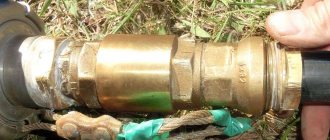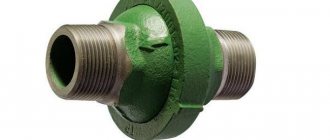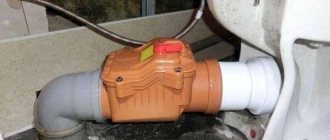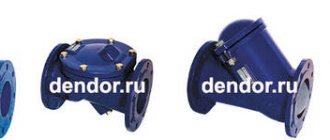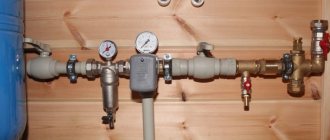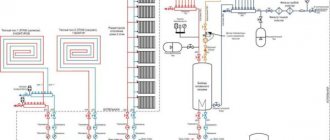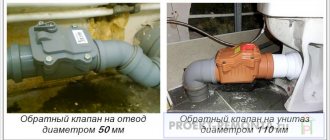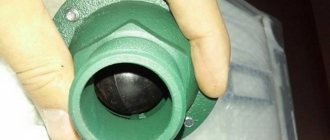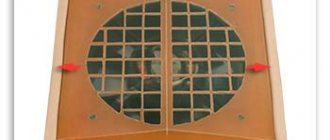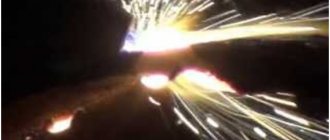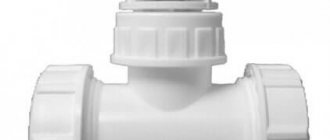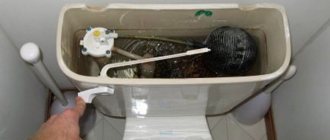A check valve for a water meter is an automatic shut-off valve that reduces the risk of ruptures and other problems during pipeline operation. Now installation of this element is required. Often the shut-off valves supplied with the meter are of unsatisfactory quality, so it is recommended to purchase them separately. This will help avoid breakdowns.
A check valve for a water meter is a part that allows liquid to pass in one direction.
Purpose and scope of use
To figure out whether a check valve is needed for water, you should consider the functions of this device. The main purpose of the element is to ensure the movement of water in only one direction.
It automatically closes the pipeline if the flow direction changes in the opposite direction. This often happens due to the difference in pressure when hot and cold water taps are opened at the same time. However, this is not the only reason why you need to install a valve.
Shut-off valves perform a number of other important functions:
- Reduces the risk of water hammer and ruptured connections.
- Blocks the flow of liquid from the hot water supply system into the cold water pipes and back.
- Prevents water from flowing down the riser when its supply is turned off.
- Prevents the formation of air pockets, etc.
Shut-off valves reduce the risk of broken connections.
A check valve is installed when installing not only a meter, but also a submersible pump, as well as a water heater.
Types of valve designs
Depending on the characteristics of the locking element, the following types of valve designs are distinguished:
- coupling;
- rotary;
- ball;
- lifting
You can buy water meters at affordable prices in our online store.
Coupling on springs
This type of shut-off valve contains a disc valve inside that can move up and down.
The spring-coupled fittings contain a disc valve inside.
When water is supplied under operating pressure, the valve opens. Thus, the liquid moves further through the pipes without hindrance. After closing the tap, under the action of the built-in spring, the shut-off disk moves down, blocking the possibility of inflow and outflow of liquid.
Rotary paddle
This type is characterized by the presence of a folding (petal) valve. It easily moves under the operating water pressure when the tap is opened. When the pressure decreases, it closes due to its own weight or a built-in spring. More often, such devices are mounted on large-diameter pipelines and industrial equipment.
Ball model
In shut-off valves, a ball acts as a valve. Under pressure, it easily moves, freeing up space for water to pass through. When the pressure decreases while closing the tap, the valve returns under its own weight to its original position, blocking the passage. This type of fittings is often used in water pipelines laid from pipes of different diameters.
In the spherical model, the ball acts as a valve.
Lifting product
In lift-type valves, a freely moving spool acts as a valve. When water moves forward, the pressure pushes the valve back, so it does not impede the passage of liquid. When reverse current flows, the spool returns to the socket, blocking the device.
Such fittings can only be installed on horizontally located pipe sections. In this case, the axis must be mounted vertically.
Tachometer counters
This type of water meters is the most common. They operate on a simple principle.
Operating principle and design
The main element of the meter is the impeller. It has a perpendicular orientation of its axis relative to the direction of the water supply. The nominal diameter of a device of this type does not exceed 50 mm.
Tachometer meters are installed to measure the flow of both cold and hot water, if we are talking about small volumes. These water meters are not designed for high flow rates.
When an avalanche of water transits through the impeller, it moves in a circle. Each is accompanied by the pouring of a certain amount of liquid through the device. The more pressure the water creates, the faster the impeller rotates.
A sensitive counting mechanism receives information about the number of revolutions through the gearbox, and all changes are shown by the dial.
Devices with an impeller can be single-jet, multi-jet, or combined. First, water is supplied to the input blades in one stream. A magnetic coupling sends a torsional impulse to the counting unit indicator. Experts advise installing such meters on hot water pipelines with a cross-section of 15 to 30 mm.
In multi-jet models, the flow is broken into parts on the way to the impeller. The measurement error decreases because the blades are exposed to the same force. In this case, flow turbulence is completely eliminated.
When the coverage of water use measurements needs to be expanded, a combined type tachometer device is installed. It is understood that with a change in the flow rate, one counter comes into operation. The transition occurs automatically.
A combined meter consists of a main and an additional device. The first is activated by opening the valve when large volumes of water are consumed
There is only one measuring unit, it is highly accurate and sealed, so it works even in flood conditions. For pipe diameters greater than 50 mm, a rotating turbine is installed in the design of the device instead of an impeller. In this case, the water meter is installed along the axis of the main line. The ideal place to install it is at the entrance.
Such meters are installed on pipelines of industrial enterprises with a cross-section of up to 500 mm, where significant volumes of water flow. The direction and angle of the flow is determined by a special fairing.
Advantages and disadvantages
Mechanical water meters are compact. They can be installed in remote places, so they do not spoil the interior of the room. The simplicity of the design allows these devices to be priced at an acceptable price for most consumers. The error in their readings is insignificant.
Tachometer counters are non-volatile devices. The main element in their design is the impeller placed in the water. The volume of water is calculated by the number of revolutions it makes.
The following characteristics are considered negative:
- blade wear;
- sensitivity to impurities present in water;
- dependence of water meter readings on the magnetic field;
- inability to record instantaneous flow;
- the presence of moving elements in the flow chamber.
Despite the presence of shortcomings, if you follow the verification schedule, the meter can last up to 12 years. The device does not require external power supplies to operate.
Dry and wet-propelled devices
Based on the location of the counting device, tachometer water meters are divided into dry and wet running. In the first case, the liquid has no effect on the counting mechanism. The rotational movement from the impeller is transmitted to it through a special magnetic coupling.
The mechanism is protected from corrosion by an impenetrable partition. The model has a fairly high cost, but it can be used even where hot water is supplied, which contains foreign impurities in large quantities.
In addition, the accuracy of the readings of such a device is very high. If there is a need for remote data acquisition, you can include a pulse output device in the system.
Mount the pulse output unit directly at the pipeline inlet. The information transformed into an impulse is sent to the recording device
The module collecting information can be located at any distance from the measurement site.
In a wet-flow device, the counting unit is in constant contact with dirty liquid. This negatively affects the duration of its service. To correct the situation, a filter is installed in front of the meter.
Specifications
Technical characteristics of shut-off valves depend on its type and size. Most often, when installing a water meter, a spring-mounted check valve is used. The body is made of cast iron, steel or alloys of non-ferrous metals. The operating pressure of the fittings is 16-40 bar, and the minimum is 0.05 bar.
The temperature range at which the product can operate is from - 20°C...+100°C. The minimum pressure drop when opening the valve reaches 0.025 bar, and when closing - 0.05 bar. The thread in the fittings is inch ISO 228/1 GOST 6357-81. The average service life of such valves is 30 years.
Other parameters of water meters
How to choose a household water meter so that the device serves without interruptions and errors in measurement results? In addition to the criteria listed above in our article, there are a number of parameters that play an important role when choosing a device:
The installation length is the distance from the end of one thread to the end of another, which determines the likelihood of installing the water meter in the right place. In most cases, they are found with an installation length of 110 mm.
The sensitivity limit is a criterion for accounting for energy resources when the impellers or turbine of the device begin to rotate, that is, consumption is recorded. The standard sensitivity limit for household meters is 15 l/hour. On sale you can also find water meters with a sensitivity limit of 1 l/hour.
Pressure loss is a parameter that determines how much the water pressure will drop as it flows through the device. Standard meters reduce pressure from 0.6 bar.
The interval between verifications is an indicator indicating the period during which the measurement accuracy specified in the passport must be maintained. The time interval is usually 3-4 years. Water meters are required to undergo periodic verification by state metrology.
The presence of a check valve will prevent the reverse flow of liquid and protect the device from water hammer, thereby extending the service life of the water meter.
How does a check valve work?
The operating principle of all types of valves is approximately the same. Under water pressure, the spool, coupling or other element that performs the locking function moves forward. In this case, nothing interferes with the flow of fluid. In case of water hammer, the internal element of the fittings reduces the pressure and the risk of pipe bursting, as well as breakdown of the water meter. After closing the valve, the spool, ball or coupling returns to its original position. Thus, the passage is blocked, which prevents the reverse flow of liquid.
Under water pressure, the coupling moves forward and allows water to pass through.
Installation instructions
If necessary, you can independently install the meter and all the necessary additional elements, incl. shut-off valves. In addition, if you wish, you can make a valve with your own hands at home. However, there are common mistakes that should be avoided when installing the device.
DIY connection diagram
When installing the meter yourself, it is extremely important to follow the sequence of connecting the elements. A ball valve is first installed on the water pipe. It comes complete with 2 O-rings, 2 nipples and 2 union nuts. Then install the filter. It is needed to prevent sand and other large debris from getting inside the meter.
After this, a water consumption meter is installed. It comes with the necessary connections for mounting. Lastly, install the check valve. It is important to follow the installation direction. Each element has an arrow indicating it.
After installation, a test run should be carried out to ensure there are no leaks.
Making a check valve yourself
Making a shut-off valve does not require expensive equipment, so you can make it yourself.
You can make a check valve yourself.
This will require
- coupling on which external threads are cut;
- spring;
- a steel ball with a diameter slightly smaller than the internal cross-section of the internal cavity;
- female tee;
- FUM tape;
- screw plug.
First of all, you need to screw the coupling into the internal threaded hole of the tee. The side hole should be blocked by approximately 2 mm. A ball and spring are inserted on the reverse side of the structure. Then the hole in the tee is plugged with a screw plug. When fixing individual parts of the structure, FUM tape is used to seal the joints. It is extremely important to ensure that the spring does not deflect when water pressure drops, but is not too rigid and does not impede the passage of liquid.
Installation errors
Most often, people who have little experience in installing fittings forget to remove the valve lock. If this element remains in the tee, the water flow will be blocked. To fix the problem, you need to dismantle the system and remove the plug.
Another common mistake is the lack of a filter. Without this element, sand can get into the fittings and block the valve. In this case, the product will need to be dismantled and washed. In addition, the threaded coupling often breaks. This occurs due to using too much sealant and increasing pressure. It is not recommended to repair a broken coupling. Better to replace it.
Differences from a mechanical water meter
The first and most significant difference is the presence of an electronic instrument panel on an electronic meter, and its absence on a mechanical one.
This display makes it possible to display readings in a convenient plane, transmit them via Wi Fi, or via a wired network to any connected device.
Some models transfer data directly to the service provider. Electronic water meters require a battery or a constant source of electricity.
Reference! The size of both types of counters is approximately the same. Therefore, if you replace a mechanical water meter with an electronic one, no additional space will be needed.
Comparison table of mechanical and electrical meter:
| Mechanical | Electronic | |
| Price category | Budget, cheap | Expensive |
| Accuracy of measurements | Accuracy varies and may degrade over time | The readings are accurate and do not deteriorate |
| Ease of use | Readings are taken only on the device itself, manually. | The ability to display an electronic panel with indicators in a convenient place. Data transfer via the Internet, wired connection and directly to the water supply company. |
| Electricity or battery requirement | Absent | The need for a constant supply of electricity or periodic change (recharge) of the battery |
| Verification frequency | From 4 to 7 years | Up to 10 years, without the need to remove the entire mechanism |
